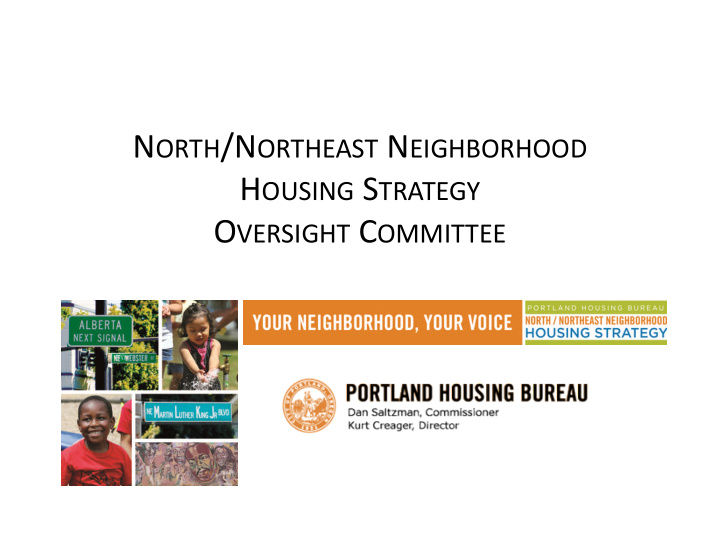



N ORTH /N ORTHEAST N EIGHBORHOOD H OUSING S TRATEGY O VERSIGHT C OMMITTEE
Portland Housing Bureau N/NE Preference Policy Tuesday, December 15, 2015
Background: N/NE preference policy • City urban renewal has marginalized and displaced historic residents of North and Northeast Portland • Future city actions should mitigate marginalizing or displacing community members
Background: N/NE preference policy • Designed to give preference to marginalized families with historic roots in North and Northeast Portland • Preference for families currently in the community as well as those who have already been displaced
Background: N/NE preference policy • Would apply to rental housing and homeownership programs in North and Northeast Portland • Preference policies affect the order of the list for services, not program eligibility • Housing Bureau programming is for low and moderate income households
Goals of the Preference Policy 1. Give preference to families based on the amount of urban renewal activity that occurred where they lived 2. Address generational displacement of families by urban renewal 3. Give preference to families regardless of where they currently live 4. Give top priority to families with property taken by the city
Accomplishing Goal 1 Give preference to families based on the amount of urban renewal activity that occurred where they lived What does this mean for the Preference Policy? Mapping urban renewal activities in North and Northeast Portland shows areas of highest concentration Offer more preference points if families have lived in areas with more urban renewal activity
Geography One: Area of City Condemnation Actions (1950s-1970s) Numerous city condemnation actions occurred associated with Emanuel Hospital, Memorial Coliseum, and Albina Planning
Geography Two: Albina Community Plan Boundary (1990s) Numerous city actions occurred as a part of the Albina Community Plan that marginalized and displaced vulnerable households
Geography Three: Urban Renewal Areas (2000s-present) Numerous city actions occurred as a part of urban renewal that marginalized and displaced vulnerable households
Albina Community Plan Boundary + Urban Renewal Areas + Areas of City Condemnation Actions 0 Point Area 1 Point Area 2 Point Area 3 Point Area
Accomplishing Goal 2 Addressing generational displacement of families by urban renewal What does this mean for the Preference Policy? Families whose ancestors resided in North and Northeast Portland are eligible for additional preference points
Accomplishing Goal 2 Households Applying Household’s Ancestors 0 to 3 0 to 3 + Preference Preference Points Possible Points Possible
Accomplishing Goal 3 Give preference to families regardless of where they currently live What does this mean for the Preference Policy? Families can use their current or former address
Accomplishing Goal 4 Give top priority to families with property taken by the city What does this mean for the Preference Policy? Families who have had property taken by the city in North and Northeast Portland move to the top of the list
The Portland Housing Bureau has identified lists of names of people whose property was taken by the city through the use of eminent domain Albina Names Emanuel Names Memorial Coliseum Names Households applying for services who are the direct descendant of someone whose name is on one of the lists will receive the highest level of priority *If a family is not on the list but should be, the Housing Bureau will work with the family to address this
Structure of the Policy • Policy orders the waitlist by giving families points, those with the most points are given top priority • Preference points are given based on where a family and their ancestors have lived in relation to urban renewal in North and Northeast Portland • A family can get 0-6 points total • Families who have had property taken by the city move to the top of the list
Key Takeaways • Preference policy applies to rental housing and homeownership programs in North and Northeast Portland • Preference policy affects the order of lists, not eligibility for programs • Households whose family property was taken by the city will receive top priority • Households ranked based on address history for themselves and their ancestors
Next Steps for Preference Policy • Housing Bureau to develop tools and internal infrastructure to implement policy • Housing Bureau to work with community providers to implement policy • Housing Bureau to work with other community based organizations to build awareness and understanding of policy • Housing Bureau to review program requirements , including market and screening standards, to improve access to programs
Questions ?
GRANT WAREHOUSE Development Team Update
Community Outreach • Initial Outreach • FAQs on PCRI webpage, updates via PCRI, PHB news • Ads in Observer, Skanner to announce team • Preparing site sign with team info, web address • Planning community outreach forums starting in the 1 st quarter of 2016 • Ongoing updates to N/NE Advisory Committee • Community forum at completion of schematic design (est. February 2016) • Commercial design/needs charrette • Forum with Eliot Neighborhood Association
MWESB Professional Services • Initiated Outreach • Conducted outreach to firms identified by OAME, MCIP, NAMC Oregon, TriMet, State MWESB directory and through existing relationships • Personal contact to identified firms • Shared via PCRI website and social media • Announcement/contact at OAME Meeting • Have identified prospective MWESB firms in nearly every area we anticipate contracting • Future outreach as needed for additional services
Pre-Development • Carleton Hart Architects (CHA) conceptual designs • Testing site layouts and floor plans • Zoning and massing study • Unit count, mix and layout • Retail and community room programming • Parking • Programming options: 52 units vs. 81 units
52 UNIT SCHEME
81 UNIT SCHEME
Recommended Budget Change • 52 unit program: • Fully utilizes subsidy offered: $4.5M • “Under-builds” site • 81 unit program: • Maximizes site density • Adds little soft or financing costs • Requires additional PHB subsidy: $7M total (per unit subsidy is virtually identical)
Recommend
More recommend